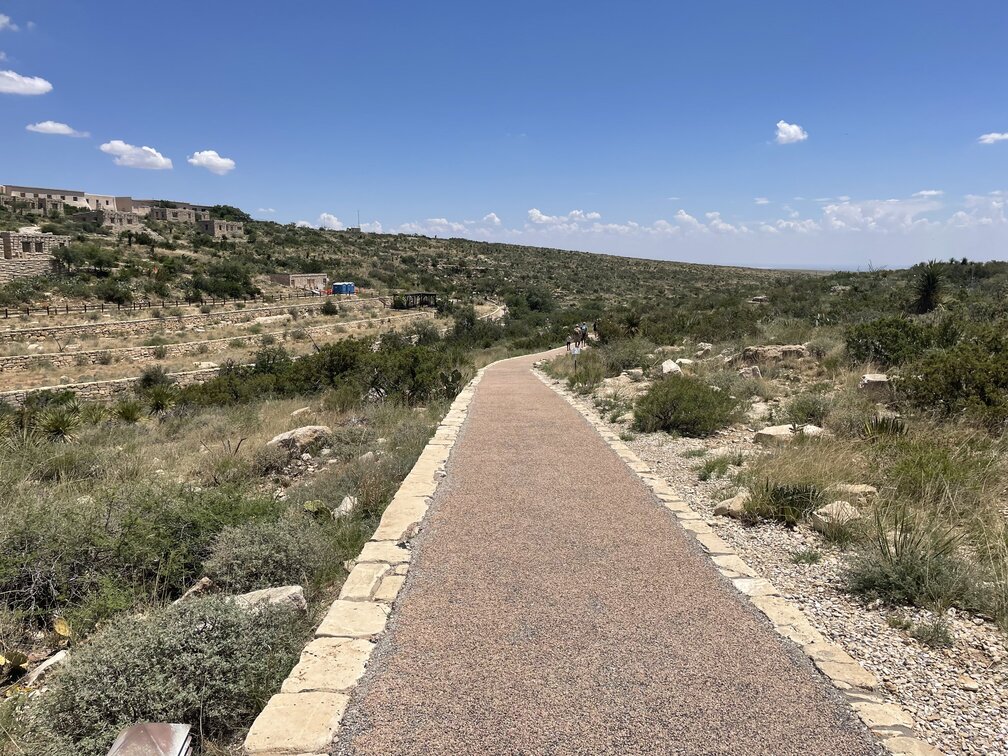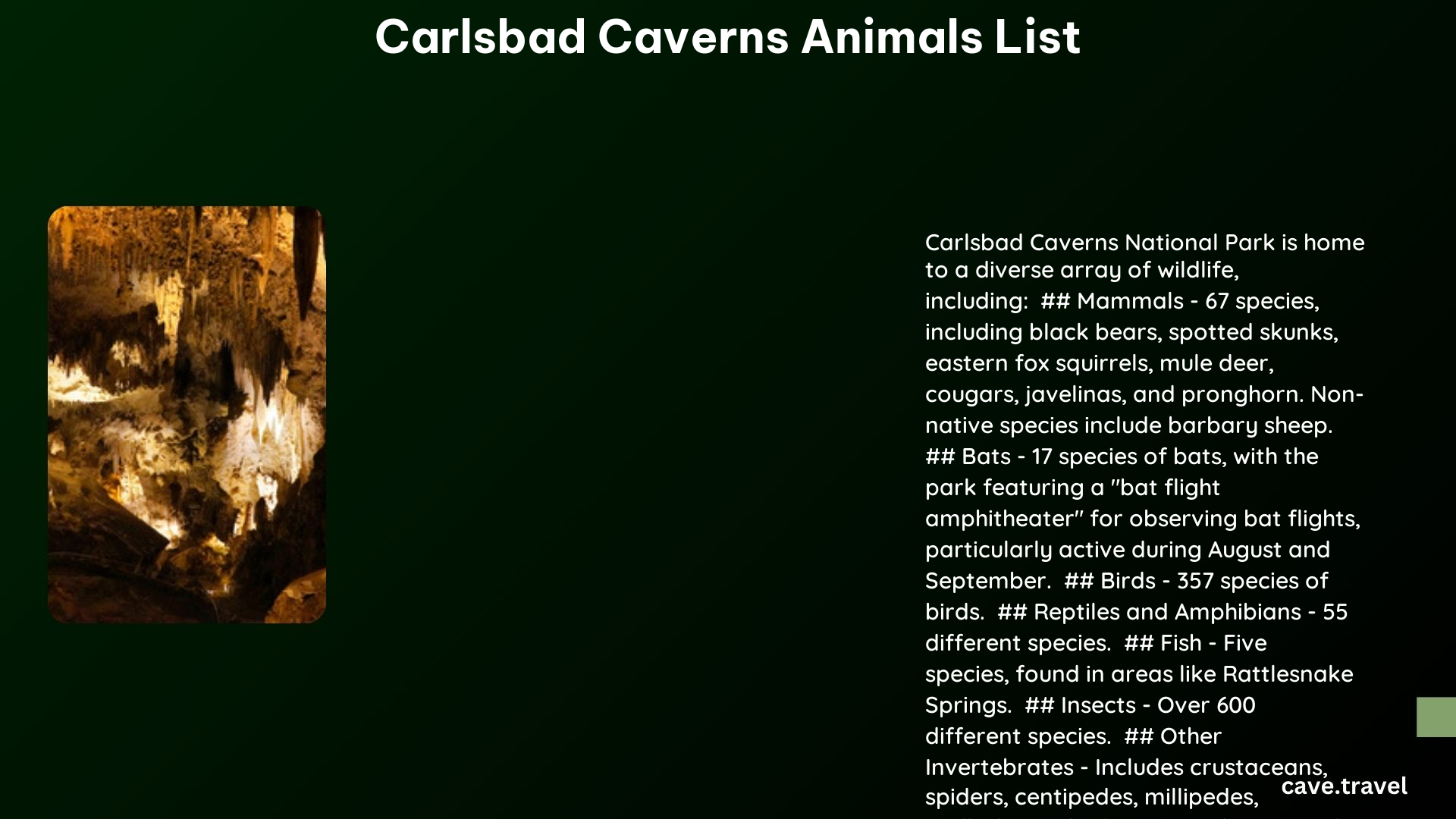Carlsbad Caverns National Park is home to a diverse array of wildlife, including 67 mammal species, 17 bat species, and numerous birds, reptiles, and insects. The park’s unique ecosystem, ranging from desert scrublands to underground caverns, supports a rich biodiversity. This comprehensive guide explores the fascinating animals that inhabit this remarkable national park, their adaptations, and conservation efforts to protect them.
What Mammals Can Be Found in Carlsbad Caverns?

The mammalian fauna of Carlsbad Caverns National Park is diverse and includes:
- Bats (17 species)
- Carnivores (e.g., black bears, coyotes, bobcats)
- Ungulates (e.g., mule deer, javelinas)
- Rodents (e.g., prairie dogs, kangaroo rats)
- Lagomorphs (cottontails and jackrabbits)
Bat Species in Detail
| Species | Scientific Name | Notable Characteristics |
|---|---|---|
| Brazilian Free-tailed Bat | Tadarida brasiliensis | Forms colonies up to 400,000 individuals |
| Western Spotted Skunk Bat | Euderma maculatum | Rare, distinctive spotted pattern |
| Pocketed Free-tailed Bat | Nyctinomops femorosaccus | Adapted for fast flight |
| Big Free-tailed Bat | Nyctinomops macrotis | Large size, powerful flyer |
How Do Bats Contribute to the Caverns’ Ecosystem?

Bats play a crucial role in the Carlsbad Caverns ecosystem:
- Pest Control: They consume vast quantities of insects, including agricultural pests.
- Nutrient Cycling: Bat guano supports unique cave ecosystems and microorganisms.
- Temperature Regulation: Large colonies help maintain stable cave temperatures.
What Other Notable Mammals Inhabit the Park?
Besides bats, other significant mammals in the park include:
- Black Bears: Occasionally spotted in wooded areas
- Cougars: Elusive predators that roam the park’s rugged terrain
- Javelinas: Pig-like mammals adapted to desert environments
- Ringtails: Nocturnal, cat-sized carnivores adept at climbing
How Have Animals Adapted to the Carlsbad Caverns Environment?
Animals in Carlsbad Caverns have developed unique adaptations:
- Bats: Echolocation for navigating dark caves
- Ringtails: Long tails and large ears for balance and nocturnal hunting
- Javelinas: Tough snouts for foraging in spiny vegetation
- Desert Bighorn Sheep: Sure-footedness for navigating steep terrain (historically present)
What Endangered or Protected Species Are Found in the Park?
Several species in Carlsbad Caverns are of conservation concern:
- Desert Bighorn Sheep: Extirpated in the 1960s, potential reintroduction candidate
- Pronghorn: Population fluctuations monitored closely
- Black-tailed Prairie Dog: Subject to ongoing conservation efforts
How Does the Park Protect Its Wildlife?
Carlsbad Caverns National Park employs various conservation strategies:
- Habitat Protection: Preserving diverse ecosystems from desert to woodland
- Reintroduction Programs: Efforts to restore native species like javelinas
- Monitoring and Research: Ongoing studies of wildlife populations and distributions
- Education: Informing visitors about wildlife conservation and responsible viewing
What Unique Behaviors Can Visitors Observe in Carlsbad Caverns’ Animals?
Visitors to Carlsbad Caverns can witness fascinating animal behaviors:
- Bat Flights: Spectacular evening emergences of Brazilian free-tailed bats
- Nocturnal Activity: Opportunities to spot ringtails and other night-active species
- Seasonal Migrations: Changes in wildlife presence throughout the year
- Foraging Patterns: Observing animals like javelinas searching for food in desert habitats
How Do Seasonal Changes Affect Wildlife in the Park?
Seasonal variations significantly impact Carlsbad Caverns’ wildlife:
- Spring: Bat colonies return, breeding season for many species
- Summer: Peak activity for most animals, bat populations at their largest
- Fall: Preparation for winter, some species begin migrations
- Winter: Reduced activity, some bats hibernate or migrate south
By understanding the diverse Carlsbad Caverns animals list and their behaviors, visitors can gain a deeper appreciation for this unique ecosystem and the importance of its conservation.
References:
1. Mammals – Carlsbad Caverns National Park
2. Mammals of Carlsbad Caverns National Park, New Mexico
3. Get to Know Carlsbad Caverns Wildlife
